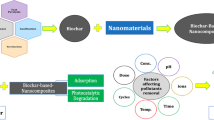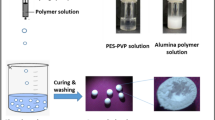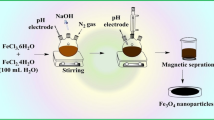Abstract
The effects of varying operating conditions on metals removal from aqueous solution using a novel nano-size composite adsorbent are reported in this paper. Characterization of the composite adsorbent material showed successful production of carbon nanotubes on granular activated carbon using 1 % nickel as catalyst. In the laboratory adsorption experiment, initial mixed metals concentration of 2.0 mg/L Cu2+, 1.5 mg/L Pb2+ and 0.8 mg/L Ni2+ were synthesized based on metals concentration from samples collected from a semiconductor industry effluent. The effects of operation conditions on metals removal using composite adsorbent were investigated. Experimental conditions resulting in optimal metals adsorption were observed at pH 5, 1 g/L dosage and 60 min contact time. It was noted that the percentage of metals removal at the equilibrium condition varied for each metal, with lead recording 99 %, copper 61 % and nickel 20 %, giving metal affinity trend of Pb2+ > Cu2+ > Ni2+ on the adsorbent. Langmuir’s adsorption isotherm model gave a higher R2 value of 0.93, 0.89 and 0.986 for copper, nickel and lead, respectively, over that of Freundlich model during the adsorption process of the three metals in matrix solution.
Similar content being viewed by others
References
Acharya, J.; Sahu, J. N.; Mohanty, C. R.; Meikap, B. C., (2009). Removal of lead (II) from wastewater by activated carbon developed from Tamarind wood by zinc chloride activation. J. Chem. Eng., 149, 249–262 (14 pages).
APHA; AWWA; WEF, (2005). Standard methods for the examination of water and wastewater. 21st edition. American Public Health Association, American Water Works Association and the Water Environment Federation. Washington DC., USA.
Atafar, Z.; Mesdaghinia, A.; Nouri, J.; Homaee, M.; Yunesian, M., (2010). Effect of fertilizer application on soil heavy metal concentration. Environ. Monitor. Assess., 160(1–4), 83–89 (7 pages).
Babel, S.; Kurniawan, T. A., (2004). Cr (VI) removal from synthetic wastewater using coconut shell charcoal and commercial activated carbon modified with oxidizing agents and/or chitosan.Chemosphere, 54(7), 951–967 (17 pages).
Bansal, R. C.; Goyal, M., (2005). Activated Carbon Adsorption. London, Taylor and Francis Group, 351–353 (3 pages).
Bong, K. P.; Seung, H. S.; Young, J. Y., (2004). Selective Biosorption of Mixed Heavy Metal Ions using Polysaccharides. Korean J. Chem. Eng., 21(6), 1168–1172 (5 pages).
Chai-Chih, C.; Wei-Long, L.; Wen-Jauh, C.; Jin-Hua, H., (2008). Temperature and substrate dependence of structure and growth mechanism of carbon nanofiber. Appl. Surf. Sci., 254, 4681–4687 (7 pages).
Chantawong, V.; Harvey, N. W.; Bashkin, V. N., (2003). Comparison of Heavy Metals Adsorption by Thai Kaolin and Ballclay. Water Air Soil Poll., 148, 111–125 (15 pages).
Chen, J.; Yiacoumi, S.; Blaydes, T. G., (1996). Equilibrium and kinetic studies of copper adsorption by activated carbon. Sep. Tech., 6, 33–146 (114 pages).
Chen, J. P.; Wang, X., (2002). Removing copper, zinc, and lead ion by granular activated carbon in pretreated fixed-bed columns. Sep. Purif. Tech., 19, 157–167 (10 pages).
Corapcioglu, M. O.; Huang, C. P., (1987). The adsorption of heavy metals onto hydrous activated carbon.Water Res., 21(9), 1031–1044 (14 pages).
Department of Environment-DOE., (1979). Environmental Quality (Sewage and industrial effluents) Regulations 1978, In: Environmental Quality Act 1974. E-publishing Lawnet, Malaysia (34 pages).
Edwin, V. A., (2008). Surface Modification of Activated Carbon for enhancement of Nickel (II) adsorption. E-J. Chem., 5(4), 814–819 (5 pages).
Freundlich, H.; Hatfield, H., (1926). Colloid and Capillary Chemistry. Methuen and Co. Ltd., London.
Garg, V. K.; Gupta, R.; Yadav, A. B.; Kumar, R. D., (2003). Dye removal from aqueous solution by adsorption on treated sawdust. Bioresour. Tech., 89(2), 121–124 (5 pages).
Georg, S.; Max, B., (2008). Adsorption of ions onto high silica volcanic glass. Appl. Rad. Iso., 66(1), 1–8 (8 pages).
Goel, J.; Krishna, K.; Chira, R.; Vinod, K., (2005). Removal of lead (II) by adsorption using treated granular activated carbon and column studies. J. Hazard. Mater., 125(1–3), 211–220 (9 pages).
Issabayeva, G.; Aroua, M. K.; Sulaiman, N. M., (2007). Continuous adsorption of lead ions in a column packed with palm shell activated carbon. J. Hazard. Mater., 155(1–2),109–113 (4 pages).
Issabayeva, G.; Aroua M. K.; Sulaiman, N. M., (2006). Electrodeposition of copper and lead on palm shell activated carbon in a flow-through electrolytic cell. Desalination, 194( 1–3), 192–201 (9 pages).
Kabbashi, N. A.; Atieh, A. M.; Mamun, A. A.; Mirghani, M. E. S.; Alam M. Z.; Yahya N., (2009). Kinetic Adsorption of Application of Carbon Nanotubes for Pb(II) Removal from Aqueous Solution. J. Environ. Sci., 21, 539–544 (5 pages).
Langmuir, I., (1918). The adsorption of gases on plane surfaces of glass, mica and platinum. J. Am. Chem. Soc., 40(8), 1361–1403 (43 pages).
Li, Y. H.; Ding, J.; Luan, Z. K.; Di, Z. C.; Zhu, Y. F.; Xu, C. L; Wu, D. H.; Wei, B. Q., (2003). Competitive adsorption of Pb2+, Cu2+ and Cd2+ ions from aqueous solutions by multiwalled carbon nanotubes. Carbon, 41, 2787–2792 (6 pages).
Li, Y. H.; Zhao, Y. M.; Hu, W. B.; Ahmad, I.; Zhu, Y. Q.; Peng, X. J.; Luan Z. K., (2007). Carbon nanotubes-the promising adsorbent in wastewater treatment. J. Phys., 61, 698–702 (5 pages).
Nora, S.; Mamadou, S. D., (2005). Nanomaterials and Water Purification: Opportunities and Challenges. J. Nanoparticle Res., 7(4–5), 331–342 (12 pages).
Nouri, J.; Khorasani, N.; Lorestani, B.; Karami; M.; Hassani, A. H.; Yousefi, N., (2009). Accumulation of heavy metals in soil and uptake by plant species with phytoremediation potential. Environ. Earth Sci., 59(2), 315–323 (9 pages).
Nouri, J.; Lorestani, B.; Yousefi, N.; Khorasani, N.; Hasani, A. H.; Seif, S.; Cheraghi, M., (2011). Phytoremediation potential of native plants grown in the vicinity of Ahangaran lead-zinc mine (Hamedan, Iran). Environ. Earth Sci., 62(3), 639–644 (6 pages).
Onundi, Y. B.; Mamun, A. A.; Al Khatib, M. F.; Ahmed, Y. M., (2010). Adsorption of copper, nickel and lead ions from synthetic semiconductor industrial wastewater by palm shell activated carbon. Int. J. Environ. Sci. Tech., 7(4), 751–758 (8 pages).
Pingle, L.; Lefferts, L., (2006). Preparation of Carbon Nano-fiber Washcoat on Porous Silica Foam as Structured Catalyst Support. Chin. J. Chem. Eng., 14, 294–300 (7 pages).
Samuel, D. F.; Osman, M. A., (1987). Adsorption Processes for Water Treatment, Butterworths, U.S.A.
Shoushan, F.; Michael, G. C.; Nathan, R. F.; Thomas, W. T.; Alan, M. C.; Hongjie, D., (1999). Self-oriented regular arrays of carbon nanotubes and their field emission properties. Science, 283, 512–514 (3 pages).
Vieira, R.; Ledoux, M. J.; Huu, C. P., (2004). Synthesis and characterization of carbon nanofibres with macroscopic shaping formed by catalytic decomposition of C2H6/H2 over nickel catalyst. J. Appl. Catal. A., 274, 1–8 (8 pages).
Zhang, Y.; Qina, Y.; Suna, X; Zhanga, J.; Jinga, C., (2008). Synthesis of carbon nanotube using cesium carbonates catalyst by chemical vapor deposition. Mater Lett., 62(21–22), 3776–3778 (3 pages).
Zhou, J. H.; Zhang, M. G.; Zhao, L.; Lia, P.; Zhou, X. G.; Yuana, W. K., (2009). Carbon nanofiber/graphite-felt composite supported Ru catalysts for hydrogenolysis of sorbitol. Catal. Today, 147, 225–229 (5 pages).
Zvinowanda, C. M.; Okonkwo, J. O.; Shabalala, P. N.; Agyei, N. M., (2009). A novel adsorbent for heavy metal remediation in aqueous environments. Int. J. Environ. Sci. Tech., 6(3), 425–434 (10 pages).
Author information
Authors and Affiliations
Corresponding author
Rights and permissions
About this article
Cite this article
Onundi, Y.B., Mamun, A.A., Khatib, M.F.A. et al. Heavy metals removal from synthetic wastewater by a novel nano-size composite adsorbent. Int. J. Environ. Sci. Technol. 8, 799–806 (2011). https://doi.org/10.1007/BF03326263
Received:
Revised:
Accepted:
Published:
Issue Date:
DOI: https://doi.org/10.1007/BF03326263




